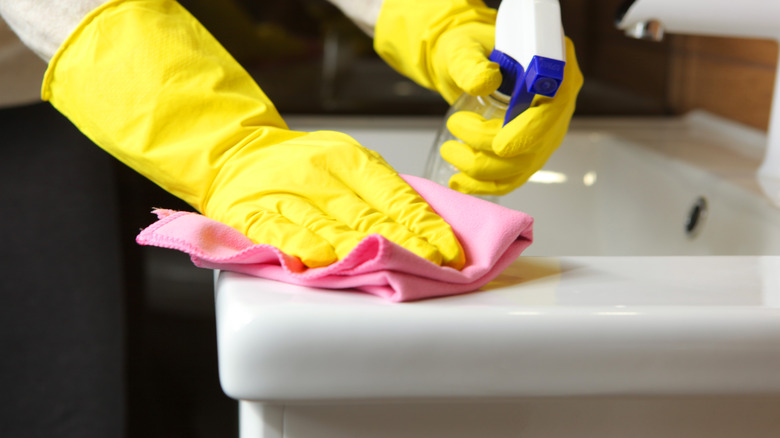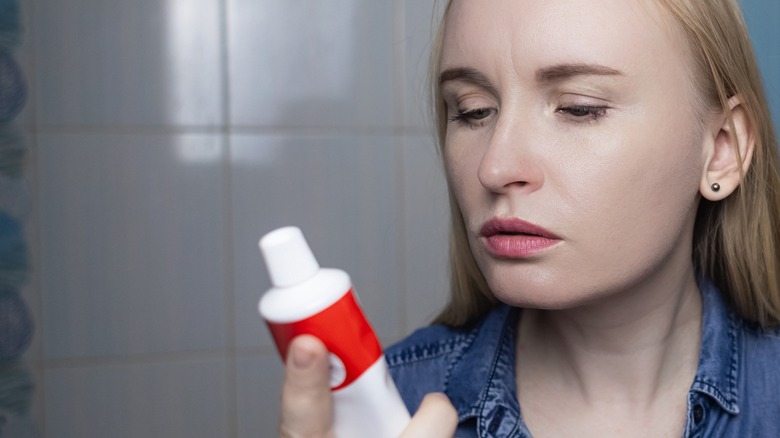The Secret To A Sparkling Clean Sink Is Already In The Bathroom
We may receive a commission on purchases made from links.
You've spent ages searching for the perfect bathroom sink that will amp up your home. It took a big chunk out of your renovation budget, but it's worth it; the sink is a stunning centerpiece. Now, however, you want to give the fixture the longest life possible. Happily, the unexpected cleanser hinted at in the title of this article is toothpaste. Yup, the very same tube you have propped up in the holder next to your toothbrushes. The minty mush is heralded for its built-in scrubbing and scum-fighting properties but it may even deal with those pesky hard water stains. Toothpaste does wonders for your enamel-based teeth so it's not a stretch to imagine it can do the same for your glazed ceramic sink.
However, a tube of toothpaste won't do a better job than conventional bathroom cleaning products. For example, a 32-ounce bottle of standard bathroom cleaning spray is cheap, available for sale online and in supermarkets and big box retailers everywhere, formulated specifically for its purpose, and typically lasts well past a single week's clean. It doesn't mean this idea is obsolete though. Use toothpaste as a cleaner in a pinch — like, say, when the dinner guests are on their way and you've just that minute run out of sink scrub — or to spot-clean stubborn stains. The latter is something toothpaste is particularly useful for, especially on white or pale-hued ceramic bathroom fixtures like basins.
Why toothpaste makes a useful bathroom sink cleaner
There are a few ways toothpaste gets your teeth clean — and any other hard, shiny surface you choose to use it on, too. For one, toothpastes contain one or some combination of calcium carbonate, calcium phosphate, and silica, making the product mildly abrasive. Toothpaste's cleaning power comes from the addition of foaming and stain-removing agents called surfactants — chemicals like sodium lauryl sulfate, dimethicones, papain, and sodium bicarbonate (aka good ol' baking soda). Toothpaste might also help keep your bathroom a germ-free zone. Many tooth care solutions are formulated to include antibacterial additives like triclosan or zinc chloride, which also appear in regular bathroom cleaning products.
That plain white toothpaste you used as a kid, before pastes with green gel stripes and flecks of blue whatever-that-even-is became popular, is arguably best for this task. A 5.7 ounce tube of Crest Cavity Protection Toothpaste with baking soda sells for just over $2 at Walmart. Check the packaging information for the RDA (Relative Dentin Abrasivity) score. One that's closer to the 250 limit set by the American Dental Association will have more dirt-fighting oomph. For tough stains, Tom's of Maine toothpaste generally boasts an RDA score on the higher side, as do Dentisse and Colgate Sensitive Max. Don't go out of your way, though. Really, whatever you have on hand will work and, perhaps more importantly, it won't do any harm, either.
How to use toothpaste to clean your bathroom sink
Do splotches of toothpaste fall into the sink every time you brush? Use that cleaning cloth you stow away in the under-the-sink storage space in your bathroom or even a wad of toilet paper to smoosh the stray dot of toothpaste around the sink using said implement. Then, rinse the basin with fresh water. Alternatively, wet the sink just a little, squeeze out up to three dollops of toothpaste onto a sponge, cleaning rag, or even an old (soft-bristled) toothbrush, and spread that around the sink. Rub the product into the surface as you go and rinse well once again. You could also add a decent squirt of toothpaste to a bowl filled with a little under a cup of distilled white vinegar and a few tablespoons of table salt. Mix thoroughly, then decant the solution into a spray bottle.
Toothpaste is abrasive by design; it's what gets your pearlies white. Be sure to apply it to a soft cloth rather than a scrubby to avoid scratches. Note, too, that this hack works best for white or light-colored sinks made from glazed ceramic, enamel, or glass. Toothpaste might stain acrylic basins or those with dark tones. If you've tried and failed to use this hack in a last ditch effort to save a dirty sink, replacing it might be your only option. Don't throw out the old one, though! There are tons of genius ways to repurpose an old sink around your home and garden.

